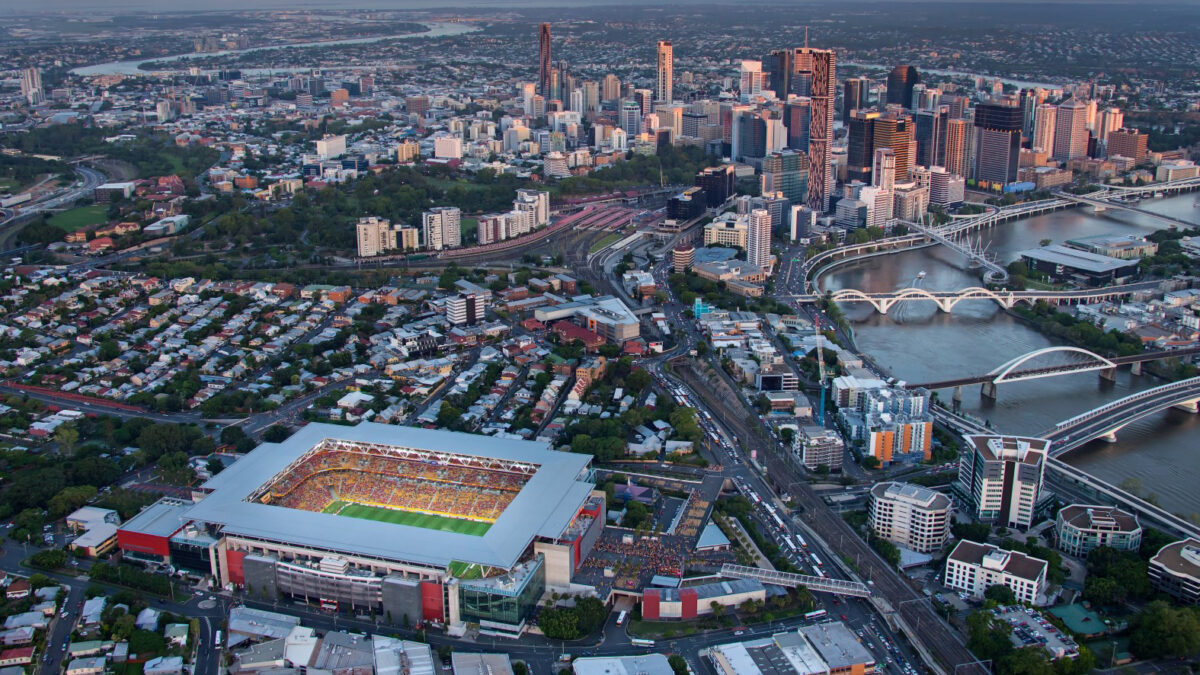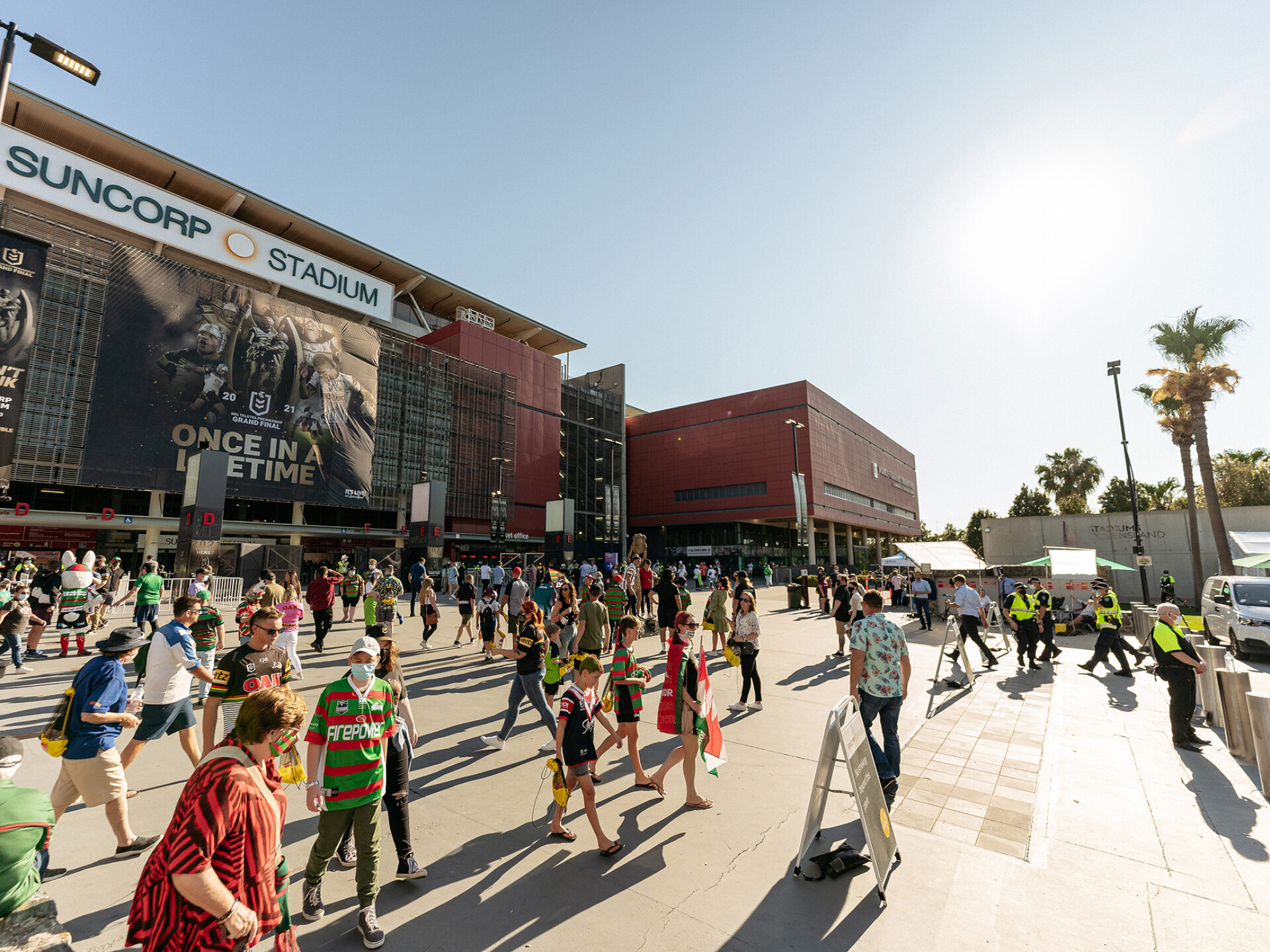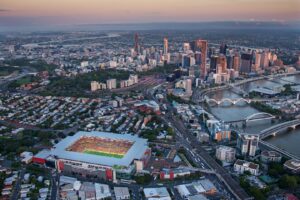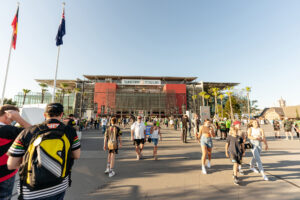News

December 2, 2021

Celebrating a coming-of-age milestone birthday can be daunting for anyone but for a Queensland icon such as Suncorp Stadium, the endurance of hosting 18.75 million people in its 18 years is a testimony to the incredible venue it is today.
Twenty years ago, Brisbane-based global architecture firm, Populous were given the ultimate responsibility of designing their home-town stadium.

Populous’ Asia Pacific Managing Director Paul Henry believes Suncorp Stadium’s authenticity has enabled it to stand the test of time.
“The aim of the design was to create a world class stadium for Brisbane that resonated with its location and history, and that’s why it is treasured by the local community and revered for its atmosphere by players and fans everywhere.
“Suncorp Stadium has also meant Queensland design talent could be showcased on the world stage and that has helped us secure export success for Queensland with projects all over the world,” Henry said.
In addition to creating a 21st-century venue, Suncorp Stadium incorporated innovative design features to reflect the sub-tropical climate and outdoor lifestyle, also giving it a distinctively Queensland atmosphere.
“The stadium’s roof is designed to respond to the unique climate, floating above the stands to allow maximum natural ventilation and includes water efficiency measures to harvest rainwater and store it onsite for the stadium’s use,” Henry explains.
These environmental credentials are embraced by the operator who plays an active role in sustainability, waste minimisation, energy efficiency initiatives and education and outreach to staff and guests.
Senior Principal and architect Chris Paterson said looking back on the past 18 years, he feels it is Suncorp Stadium that has delivered its best performance yet.
“In the past five years it’s hosted international boxing meets of Horn vs Pacquiao, it has a great track record as a concert venue from Queen to Coldplay, it performs at its best for international rugby and for a time was the state’s home for soccer.
“The stadium’s versatility is a reflection of designing for legacy, for flexibility and for widespread use by as many people as possible.
“It is an enduring stadium precinct which continues to thrive, connect to its community and provide memory-making moments,” Paterson explains.
Twenty years ago, when the stadium configuration was discussed, a real challenge was the tight fit to get a 52,500 seat stadium into a highly populated area. So, the stadium was designed to fit the contours of the site, suppressing the structure of its large size within its neighbourhood setting.
“We knew the design of the stadium had to be a landmark, one that would work hard in its legacy as a flexible space. The use of plazas were the key to linking the stadium with the surrounding suburbs, the transport systems and to the city.
“We also looked at how the design could increase the footprint of the northern plaza so more public space could be opened up.
“To ensure the stadium integrated further into the community, horizontal roof planes were designed to diminish the scale of the building as well as providing a means of enclosing noise and light.
“The stadium is so well concealed within its community that the local businesses and residents living and working around it share a close bond and connection to it,” Paterson said.

Since the grand opening in 2003, the venue has hosted a wide variety of sporting events, major international concerts and entertainment events, employing up to 1,200 to 2,000 people on major event days.
It is also a multi-use venue hosting charity and community events and is the home to several corporate organisations including the owners, Stadiums Queensland, the operators, ASM Global and community groups such as the PCYC.
“Inside the venue, spaces are used for functions, conferences and special emergency response training while outside the public space is used for health and fitness, community gatherings and festivals.
“It may look like a quiet place on non-game days – however, there is a whole lot more going on in this stadium behind its façade,” Paterson explains.
Over the years the iconic venue has been called many affectionate names by its fans.
‘The Cauldron’ for the experience it delivers to both player and spectator, or Lang Park by the serious sporting fans who have known the stadium from way back.
Whatever you like to call it, the stadium has just celebrated the renewal of its naming rights partnership with Suncorp for up to 10 years. This is set to be one of the longest running partnerships in Australia and globally, after Stadiums Queensland and ASM Global first signed Suncorp back in 1994.
The naming rights extension is seen as a vote of confidence in Queensland’s future, with Brisbane’s local economy estimated to hit $217 billion over the next decade and then the city will play host to the biggest sporting event in the world, the 2032 Brisbane Olympic Games.
Many agree the success of Suncorp Stadium has been its transition to a critical piece of community infrastructure and a world-class destination for visitors, athletes and entertainers.
Not to mention the elation of holding the world’s first largest gathering ‘post-COVID’ in 2020, with State of Origin III drawing in 49,155 spectators in one venue.
Suncorp Stadium General Manager Alan Graham said the stadium has given fans in person, and watching at home, much-needed excitement and entertainment.
“At a time when much in our lives has changed, we’ve been so fortunate to have Queensland’s home of sports and entertainment open,” Graham said.

But it’s not just league fans who benefit – Brisbane’s tourism and hospitality sectors are the biggest winners from these economic blockbusters.
Recent economic modelling showed more than $22 million flowed into Brisbane’s hotels, restaurants, cafes, and attractions, as thousands attended NRL Magic Round Brisbane with the 16-team competition in May.
This three-day rugby league blockbuster attracted over 69,000 unique visitors, with 35,000 visitors travelling to Brisbane, including 15,000+ from interstate, generating over 82,000 hotel night stays.
In September, the stadium then played host to the 2021 NRL Grand Final. For the first-time in rugby league history this hallowed event was played outside of its regular home of NSW and on Suncorp Stadium’s turf – all for the economic benefit of the city.
In 11 years from now it will play a significant part in the 2032 Brisbane Olympic Games, hosting the Rugby 7s and Football Finals.
In between then Suncorp Stadium will deliver thousands more outstanding events, and while some may say the best is yet to come, the stadium’s best performance is itself, every time.
*Suncorp Stadium was designed by Populous in association with PDT Architects.
Image Credit: Suncorp Stadium
Lorem ipsum dolor sit amet consectetur, adipisicing elit. Non facere corporis et expedita sit nam amet aut necessitatibus at dolore enim quis impedit eius libero, harum tempore laboriosam dolor cumque.
Lorem, ipsum dolor sit amet consectetur adipisicing elit. Illo temporibus vero veritatis eveniet, placeat dolorem sunt at provident tenetur omnis, dicta exercitationem. Expedita quod aspernatur molestias eum? Totam, incidunt quos.